Agrarian societies observe their harvest festivals. In the North East the most famous harvest festival is the Bihu which is popular worldwide. The Khasi, Jaintia and Garo people observe the Shad Suk Mynsiem, the Behdeiñkhlamand Wangala Dance, respectively to offer their thanksgiving to nature for a bountiful crop. Over the years these festivals have become part of folklore with incantations to an all-powerful god or a deity.
Plagues are not a recent phenomenon hence it is possible that it visited these hills and the Behdeiñkhlamwhich translates to a log representing the plague and how it is being chased away into the nether world, became part of folklore.
In its earlier avatar this festival was called Ka Chad Soo Sngi Le Iaw meaning a dance lasting four days of which three are market days.
It transformed into its present form with the outbreak of Cholera (ka Khlam prai pynhiar) in the plains of Jaintiapur (in Sylhet) which wreaked havoc as it moved up to the Jaintia hills, then known as Ka Ri Khadar Dolloi. It was then that the name Ka Behdeiñkhlam was coined.
As the population of Jaintia Hills grew, people migrated to different areas. Accordingly the festivals also took on a different hue.The Ki Soo Langdoh or the four priestly villages – Chyrmang, Jowai, Tuber and Ialong began to observe the celebrations.
With time, features such as the Ki Rong – decorated tableaus were added. Initially, they were headless animals to signify the Cholera epidemic.
The only remnant of the past is the main part of the ceremony which is performed at the centre of Aitnar, a huge pond in Jowai where people sink their colourful tableaus and the log signifying the plague.
The name Behdeiñkhlam literally means “chasing away the log signifying the plague.
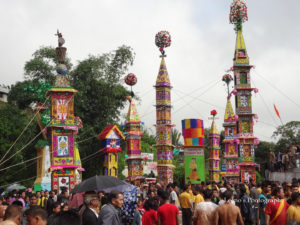 The Myth
The Myth
The rituals of this festival are tied to the story of U Lakriah and the descent of U Niaw Wasa or the seven huts through the golden ladder (Ka Tangnoob Tangjri).
U Lakriah refers to the rules of socio-religious conduct, as handed to U Niaw Wasa by U Tre Kirot or God.
The Jaintias believe that Tre Kirot created a three-layered universe.
God resides in Soorkep, the topmost layer, with the immortal angels or Ki Puri Blai; Bneiñ or heaven is the layer where people of the sixteen huts (Ki Khadynru Wasa) reside; and Earth (Sla Khyndaw Pyrthai) is the third layer.
God’s desire leads to the descent of Niaw Wasa through the golden ladder. He wanted them to prosper. U Syiem Lakriah was selected as their leader and God gifted him with divine qualities.
On behalf of the people, he maintained contact with God, who would appear before him as a rainbow – a sign of God’s covenant and a symbol of peace and hope.
The only glitch in the plan – earth was barren, thereby, making it impossible for the people to cultivate or build their huts.
U Tre Kirot then instructed Earth Mother, Ka Bei Rymaw to give three basketfuls of soil or ka le khoh le sun to make Earth productive.
In this way, the earth became green and habitable for the Niaw Wasa.
After observing the harmonious co-existence, God convened a Divine Dorbar, known as Dorbar Blai. This became the basis of the law of life. Now, it was a moral duty of the people to live together.
This divine decree or Ki Hukum evolved into a system of belief called Niamtre.
Because his work on earth was complete, God told the people that they would no longer see him.
Seeing them in tears, he negotiated with Syiem Lakriah – he would visit them once a year and stay with them for four days and three nights.
He requested for a dance, stating that they could dance anywhere – be it mud, rock or water. His people would feel his presence in their thumping hearts.The people agreed to fulfil this.
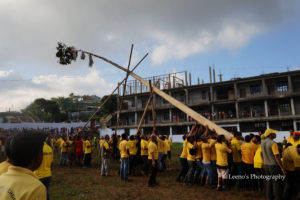 Towards Prosperity
Towards Prosperity
At this point, Syiem Pyrthat or the ‘Thunder God’ entered the picture. God ordered him as one of the Khatso Waheh (fourteen elders) to go to earth.
U Mookhai, U Mooralong, U Moosniang and U Mootong, collectively called the Ki Soodwar Sooluti (stone deities) accompanied him.
Ka Myntdu, Ka Sati Myntdu, Ka Lamynchi, Ka Sangman, Ka Syntu Ksiar, collectively known as Ki Tawiar Takan, along with U Blai Langdoh, Ka Aitnar, U Moosmai and U Ryngkaw descended to earth to protect the people and their land.
The God of Thunder decided to honour God’s instructions to live on earth with his companions till his four sisters reached Loom Sooyung at Jowai. They were Ka Bon, Ka Teiñ, Ka Wet and Ka Doh.
This marked the emergence of the founding clans – Sookpoh, San Syngkong, Challam, Passah and Chullai, or the Phra Kur Phra Kmai.
From them, sacred and secular functionaries came known as Ki Khatso Wasan – U Dalloi, Pator, U Langdoh, Ka Langdoh, among others.
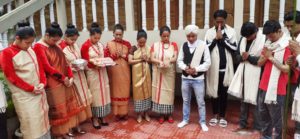 Rituals of the Festival
Rituals of the Festival
There are four mandatory rites and rituals of the festival – sacrificial offering or Ka Knia Ka Khriam (prayers offered to Ka Bei Rymaw; Ka Suid Ka Choor or libation; oblation, known as Ka Siang Ka Pha and Ka Bam Tyngkong; and Ka Ngooh Ka Dem or prayer.
Sacrifices are offered to the nature deities or Ki Blai Chnong Blai Raid so that the village/Raid are protected from natural calamities.
Libations and oblations form an important part of the festival to pay their respects to ancestors U Syiem Lakriah and the four sisters who formed the Kur or the clan and the Ka Yung or the family.
Prayers are offered to U Tre Kirot or the Supreme creator.
Before the Ka Soo Sngi Le Yaw (the last four days of Behdeiñkhlam), there are rites performed right from March onwards.
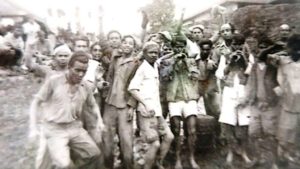 The Four Days
The Four Days
The rituals of the first day or the Ka Sngi Pynsin involves the Wasan participating in an act of alms collection (Ka Khrong Khoo Pyrnah) in the form of rice grains, used for brewing rice beer for oblations.
Once the ritual is over, important community members go to the sacred forest (Ka Khloo Paiung) to fetch and cut wooden logs needed for Ka Kyntin Khnong – a ceremony to remember the four ancestresses.
A Sarang or herb is tied at the front of Ka Iung Langdoh at the beginning of the four-day festival. This is known as the Ka Kdoh Sarang.
Food is offered to their ancestors in the afternoon at the ancestral home of each clan called the Kmai-Iung or Iung Blai.
Other rituals are observed till the evening.
The second day of the festival begins with the sacrificial offering called Ka Knia Aitnar, in honour of Ka Syiem Aitnar, the presiding deity at Aitnar.
Once again, wood is cut from the sacred Grove for the four ancestresses.
All the Dongs or localitiesdance to the beat of the Ka Bom and the tunes of Ka Bhuri to fetch their Dienkhlams.
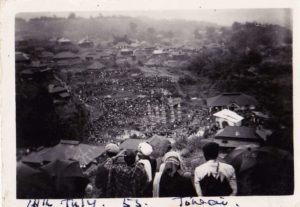 It is the responsibility of the Ki Khon Raij to fetch the Khnong Blai. The Deinkhlam and the Khnong Blai are neatly carved tree trunks. This is the path for God to come to his people.
It is the responsibility of the Ki Khon Raij to fetch the Khnong Blai. The Deinkhlam and the Khnong Blai are neatly carved tree trunks. This is the path for God to come to his people.
On the third day, the deinkhlams are erected at different places, which starts with the ancestral homes of Ka Bon and Ka Doh. All households follow suit. Libations are offered.
Dance processions continue to places of religious significance.
The last day marks the culmination of Behdeiñkhlam. It is marked by prayers and spectacular dance. Important rituals of this day involve prayers to bless mankind and prevent plagues.
The festival ends with a ceremony called the Ka Wai-Sarang. Here, the Sarang is untied.
With this, Behdeiñkhlam comes to an end, paving the way for the next fruitful, plague-free year.
(With inputs from Dr Omarlin Kyndiah, General- Secretary of Sein Raij Niamtre, Shillong)



